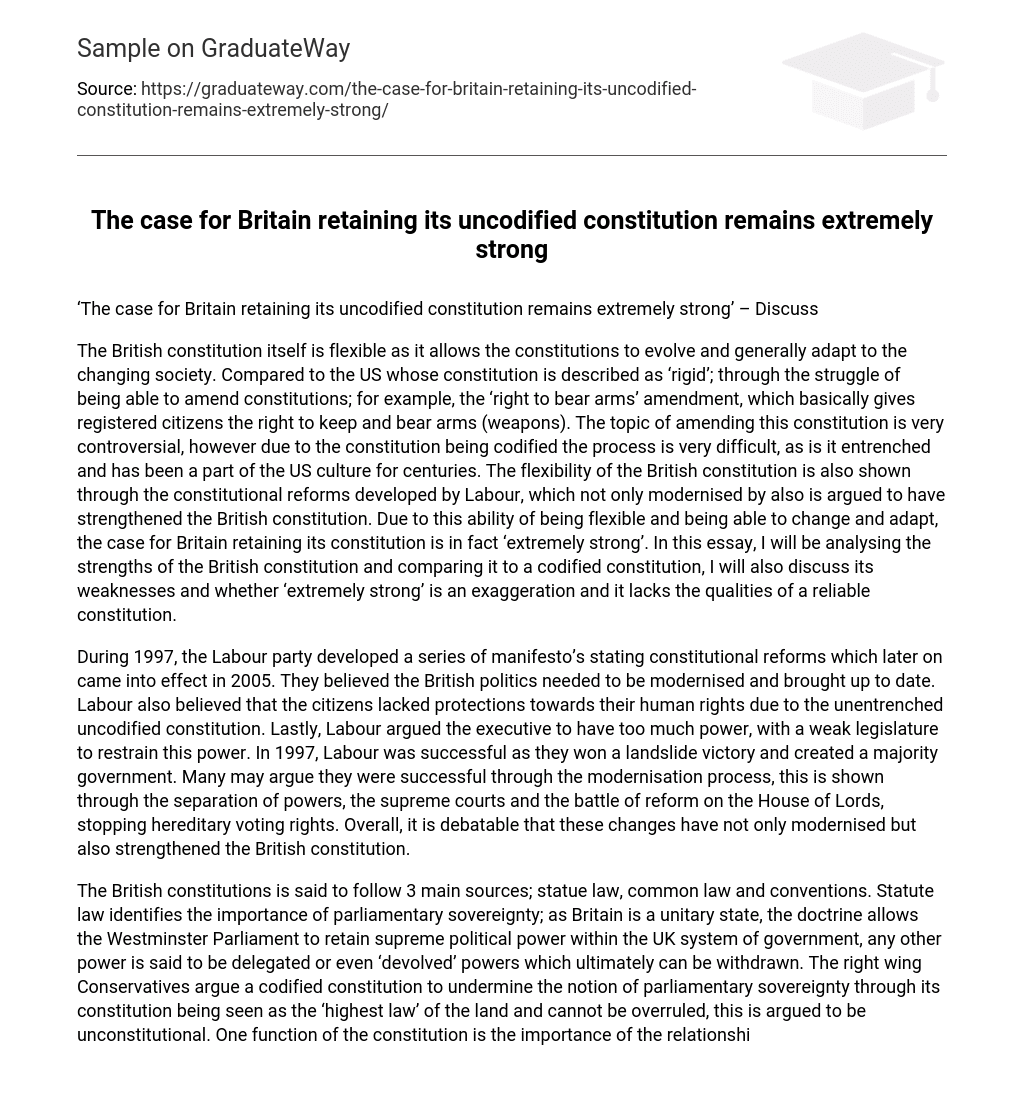While the British constitution is known for its flexibility in order to adapt and evolve with societal changes, the US constitution is often referred to as ‘rigid’ due to the challenging process of amending it. A notable example of this struggle can be seen in the amendment that grants registered citizens the right to possess and bear firearms.
Amending the constitution is a highly controversial topic, especially because it is codified, making the process difficult due to its entrenched nature and long-standing presence in US culture. The British constitution, on the other hand, demonstrates flexibility with the constitutional reforms introduced by Labour, resulting in both modernization and argued strengthening of the British constitution.
The argument for Britain keeping its constitution is highly compelling due to its flexibility, adaptability, and ability to change. This essay aims to analyze the advantages of the British constitution in comparison to a codified one. Additionally, it will discuss the drawbacks and evaluate if calling it “extremely strong” is an exaggeration or if it lacks the traits of a dependable constitution.
In 1997, the Labour party created a series of manifestos that proposed constitutional reforms. These reforms were implemented in 2005, aiming to modernize and update British politics. The Labour party also highlighted the lack of protections for citizens’ human rights caused by the unentrenched and uncodified constitution. Additionally, Labour criticized the concentration of power in the executive branch, with a weak legislature unable to limit that power.
In 1997, Labour won a decisive election and formed a majority government. The key to their success was the modernization process, which included implementing separation of powers, establishing supreme courts, and reforming the House of Lords by eliminating hereditary voting rights. These changes not only brought the British constitution into the present but also made it stronger, sparking an ongoing debate.
The British constitution is traditionally believed to originate from three main sources: statute law, common law, and conventions. Statute law highlights the principle of parliamentary sovereignty, granting the Westminster Parliament ultimate political power in the UK government system due to its status as a unitary state. Any other authority is considered delegated or devolved power and can be withdrawn if needed.
The right wing Conservatives argue that a codified constitution undermines parliamentary sovereignty by establishing it as the ‘supreme law’ of the land, which they deem unconstitutional. Bill Coxhall (1998) explains that one important role of the constitution is to regulate relationships between political institutions in Britain, including governing the connections between the state and its citizens. An example of this is how the public can elect parliament members who will represent them, forming a strong link between MPs and their constituencies. This empowers the public to hold their representatives accountable and vote them out in future elections.The British constitution is advantageous due to its flexibility, allowing it to adapt to societal changes. An example of this flexibility can be seen in the Scotland, Wales, and Northern Ireland Act 1998, which created state assemblies for elected executives in these regions.
The British constitution is intended to define citizens’ rights and ensure their awareness of entitlements, but there is debate over its clarity compared to the American system. In contrast to Americans who can purchase a constitution book that clearly establishes their rights, confusion persists in the British system. Consequently, this lack of clarity hampers general awareness and insufficiently safeguards these rights.
Some argue that a constitution lacking codification allows the government to manipulate and interpret it according to their own policies. This is because not all documents are written, and even those that are may lack firm establishment. The Human Rights Act serves as an example of a written document that lacks firm establishment, granting the government potential power to manipulate or even abolish it, although the probability of this occurring is minimal.
In conclusion, the British constitution has both strengths and weaknesses. Its strengths include parliamentary sovereignty, flexibility, and a single-tier legal system. Parliamentary sovereignty means that powers are vested in the parliament. The constitution is also flexible and can evolve and adapt. Unlike the United States, the UK follows a single-tier legal system where no law can be overruled by another.
However, there are weaknesses in the constitution as well. For example, it does not provide sufficient protections for rights and citizens often find their rights to be ambiguous. Moreover, the government has the ability to interpret and manipulate the constitution according to their own interests.
It is crucial to maintain the British constitution due to its adaptability and evolution, which has allowed the Labour party to successfully implement necessary changes.





